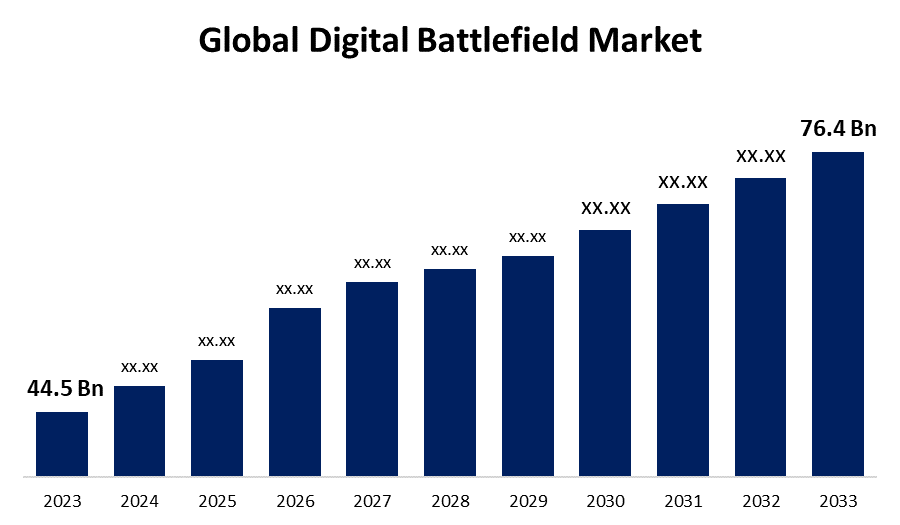Global Digital Battlefield Market Size To worth USD76.4 billion by 2033 | CAGR of 5.55%
Category: Aerospace & DefenseGlobal Digital Battlefield Market Size To worth USD 76.4 billion by 2033
According to a research report published by Spherical Insights & Consulting, The Global Digital Battlefield Market Size to grow from USD 44.5 Billion in 2023 to USD 76.4 Billion by 2033, at a Compound Annual Growth Rate (CAGR) of 5.55% during the forecast period.

Get more details on this report -
Browse key industry insights spread across 214 pages with 104 Market data tables and figures & charts from the report on the "Global Digital Battlefield Market Size, Share, and COVID-19 Impact Analysis, By Technological Innovation (Artificial Intelligence, Cyber Warfare Solutions, Simulation Training Tools, Autonomous Systems), By Application Sector (Military Operations, Defense Research, Training and Simulation, Strategic Planning), By Deployment Model (On-Premises, Cloud-Based, Hybrid Solutions), By User Type (Government Defense Agencies, Private Defense Contractors, Military Personnel), and By Region (North America, Europe, Asia-Pacific, Latin America, Middle East, and Africa), Analysis and Forecast 2023 - 2033." Get Detailed Report Description Here: https://www.sphericalinsights.com/reports/digital-battlefield-market
The digital battlefield market is evolving quickly as modern warfare adopts advanced technologies such as AI, IoT, cloud computing, and big data analytics. Militaries across the globe are investing in real-time intelligence, cybersecurity, and autonomous systems to improve situational awareness and combat effectiveness. Essential elements of this market include digital command and control (C2), electronic warfare, and network-centric operations. Increasing geopolitical tensions and the need for seamless communication between defense forces are driving market growth. North America leads in market share due to its substantial defense budgets, while the Asia-Pacific region exhibits significant growth potential. Key challenges include cybersecurity threats and the complexity of integrating new technologies. Leading companies like Lockheed Martin, Raytheon, and BAE Systems are driving innovation in secure communication and AI-enhanced battlefield management. The future of warfare is becoming more digital, with interconnected defense ecosystems reshaping modern combat strategies.
Digital Battlefield Market Value Chain Analysis
The digital battlefield market value chain consists of several interconnected stages, beginning with technology providers that develop solutions in AI, IoT, cybersecurity, and cloud computing. These innovations are integrated into battlefield systems by defense contractors like Lockheed Martin and Raytheon, which design command and control (C2), surveillance, and electronic warfare tools. System integrators play a key role in merging various digital technologies into a unified operational framework for defense forces. Governments and defense agencies are the primary purchasers, fueling demand through military modernization efforts. End-users, including the army, navy, and air force, implement these systems for real-time intelligence and enhanced combat efficiency. Supporting entities, such as R&D organizations, regulatory bodies, and cybersecurity firms, ensure compliance, security, and continued innovation, strengthening the digital battlefield ecosystem and its effectiveness.
Digital Battlefield Market Opportunity Analysis
The digital battlefield market offers substantial growth potential, fueled by rising defense budgets, growing geopolitical tensions, and rapid advancements in technology. The integration of AI, IoT, and cloud computing in military operations is revolutionizing combat strategies, enhancing real-time decision-making, and boosting operational efficiency. As digital warfare amplifies the risk of cyber threats, the demand for cybersecurity solutions is intensifying. Emerging economies in Asia-Pacific and the Middle East are making significant investments in modernizing their defense infrastructures, opening up new market opportunities. Moreover, the incorporation of unmanned systems, autonomous weapons, and 5G networks provides further expansion prospects for defense contractors and technology companies. Collaboration between governments and private-sector players in developing smart, interconnected battlefield solutions is strengthening the market, positioning it as a critical area for future defense innovation.
The digital battlefield market is witnessing substantial growth driven by the increasing demand for the integration of advanced technologies. Systems like AI, IoT, big data analytics, and 5G communication are transforming military operations, enhancing situational awareness, decision-making, and combat effectiveness. Defense forces worldwide are investing in cloud-based command and control (C2) systems, cybersecurity solutions, and autonomous platforms to strengthen their strategic capabilities. The rise of network-centric and electronic warfare further fuels the demand for seamless, real-time data exchange. Moreover, emerging economies are upgrading their defense infrastructures, contributing to market expansion. Companies are dedicating efforts to R&D to create smart, connected battlefield solutions that ensure operational efficiency and security. As digital transformation continues, technology-driven warfare is set to shape the future of global military engagements.
A primary concern in the digital battlefield market is cybersecurity threats, as increased digitalization exposes military networks to potential cyberattacks and data breaches. Integration challenges also arise, as defense forces must effectively merge diverse technologies such as AI, IoT, and cloud computing across various platforms. High implementation costs and budget limitations in some regions can hinder widespread adoption. Additionally, compatibility issues can occur when new digital solutions are integrated with legacy defense systems. Regulatory and compliance hurdles, including data privacy laws and international defense policies, add complexity to market growth. The reliance on advanced technologies also creates risks related to system failures and over-dependence on a few key suppliers. Addressing these challenges requires strong security frameworks, strategic collaborations, and ongoing innovation in defense technology.
Insights by Technological Innovation
The Artificial Intelligence segment accounted for the largest market share over the forecast period 2023 to 2033. AI-powered systems enhance situational awareness, threat detection, and predictive analytics, allowing for quicker and more precise responses in combat situations. Autonomous weapons, unmanned aerial vehicles (UAVs), and AI-driven surveillance systems are being increasingly deployed to minimize human risk and boost operational efficiency. AI also plays a vital role in cybersecurity by safeguarding military networks from cyber threats and data breaches. Governments and defense agencies are making significant investments in AI research and development to bolster their digital warfare capabilities. As AI technology evolves, its integration into military operations will further transform modern battlefield strategies on a global scale.
Insights by Application Sector
The Defense Research segment accounted for the largest market share over the forecast period 2023 to 2033. Research institutions are dedicated to advancing AI, machine learning, autonomous systems, and cybersecurity solutions to enhance battlefield effectiveness. Ongoing R&D initiatives focus on developing smarter command and control systems, cutting-edge communication networks, and advanced defense platforms like drones and robotics. Collaboration between government defense agencies and private tech companies speeds up the creation of next-generation digital warfare technologies. Additionally, defense research helps tackle integration challenges, ensuring smooth functionality across various platforms. As global defense strategies evolve toward modernization and digital transformation, the defense research sector will remain a key driver in shaping the future of military operations and strategic defense systems.
Insights by Deployment Model
The On-Premises segment accounted for the largest market share over the forecast period 2023 to 2033. On-premises solutions provide the benefit of keeping sensitive military data in secure, isolated environments, thereby minimizing the risk of cyber threats and external breaches. These systems are essential for supporting critical applications such as command and control, surveillance, and real-time data processing in military operations. Many defense forces prefer on-premises infrastructure due to its reliability, scalability, and direct control over system performance. With the growing demand for secure, high-performance digital battlefield platforms, defense agencies are increasingly investing in on-premises solutions to ensure smooth integration with legacy systems while preserving operational integrity. The ongoing need for advanced, localized systems in high-risk environments continues to drive growth in the on-premises segment.
Insights by User Type
The government agencies segment accounted for the largest market share over the forecast period 2023 to 2033. Governments around the world are focusing on advancing and deploying AI, IoT, cybersecurity, and cloud-based systems to strengthen national defense capabilities and improve operational efficiency. As defense agencies transition toward network-centric, data-driven warfare, there is an increasing demand for real-time intelligence, autonomous systems, and secure communication platforms. Additionally, governments are working closely with defense contractors and tech firms to ensure the seamless integration of advanced digital solutions into their military infrastructure. Geopolitical instability and evolving security challenges are further fueling investments in digital warfare strategies. As defense budgets continue to grow, government agencies are driving innovation and expansion in the digital battlefield market, shaping the future of global military operations.
Insights by Region

Get more details on this report -
North America is anticipated to dominate the Digital Battlefield Market from 2023 to 2033. The U.S. Department of Defense is making substantial investments in AI-driven warfare, cybersecurity solutions, and next-generation communication systems to boost battlefield efficiency. The region is also leading the way in network-centric warfare, incorporating IoT, cloud computing, and big data analytics to enable real-time decision-making. Rising concerns about cyber warfare and geopolitical tensions are fueling additional investments in digital command and control (C2) systems, electronic warfare, and unmanned platforms. Furthermore, partnerships between defense agencies and private technology companies are driving innovation, helping North America retain its leadership in the rapidly evolving digital battlefield landscape.
Asia Pacific is witnessing the fastest market growth between 2023 to 2033. China, India, Japan, and South Korea are making significant investments in AI-driven warfare, cybersecurity, and advanced communication systems to bolster their defense capabilities. The rise of network-centric warfare, electronic warfare, and autonomous military platforms is accelerating, driven by regional security concerns and territorial disputes. Governments are partnering with both local and global defense technology companies to enhance real-time intelligence, surveillance, and battlefield management systems. Additionally, innovations in 5G, IoT, and cloud computing are further reshaping digital warfare strategies. With ongoing defense modernization and increasing demand for high-tech military solutions, the Asia-Pacific region is becoming a prominent player in the global digital battlefield market.
Recent Market Developments
- In May 2024, L3Harris Technologies boosted the U.S. Army's capabilities with its latest Hawkeye III Lite Very Small Aperture Terminal (VSAT), offering dependable and scalable SATCOM solutions.
Major players in the market
- Microsoft
- Raytheon Technologies
- Palantir Technologies
- Thales Group
- Hewlett Packard Enterprise
- Northrop Grumman
- BAE Systems
- Cisco Systems
- IBM
- General Dynamics
- L3Harris Technologies
- Oracle
- Leonardo
- Lockheed Martin
- Boeing
Market Segmentation
This study forecasts revenue at global, regional, and country levels from 2023 to 2033.
Digital Battlefield Market, Technological Innovation Analysis
- Artificial Intelligence
- Cyber Warfare Solutions
- Simulation Training Tools
- Autonomous Systems
Digital Battlefield Market, Application Sector Analysis
- Military Operations
- Defense Research
- Training and Simulation
- Strategic Planning
Digital Battlefield Market, Deployment Sector Analysis
- On-Premises
- Cloud-Based
- Hybrid Solutions
Digital Battlefield Market, User Type Analysis
- Government Defense Agencies
- Private Defense Contractors
- Military Personnel
Digital Battlefield Market, Regional Analysis
- North America
- US
- Canada
- Mexico
- Europe
- Germany
- Uk
- France
- Italy
- Spain
- Russia
- Rest of Europe
- Asia Pacific
- China
- Japan
- India
- South Korea
- Australia
- Rest of Asia Pacific
- South America
- Brazil
- Argentina
- Rest of South America
- Middle East & Africa
- UAE
- Saudi Arabia
- Qatar
- South Africa
- Rest of the Middle East & Africa
About the Spherical Insights & Consulting
Spherical Insights & Consulting is a market research and consulting firm which provides actionable market research study, quantitative forecasting and trends analysis provides forward-looking insight especially designed for decision makers and aids ROI.
Which is catering to different industry such as financial sectors, industrial sectors, government organizations, universities, non-profits and corporations. The company's mission is to work with businesses to achieve business objectives and maintain strategic improvements.
CONTACT US:
For More Information on Your Target Market, Please Contact Us Below:
Phone: +1 303 800 4326 (the U.S.)
Phone: +91 90289 24100 (APAC)
Email: inquiry@sphericalinsights.com, sales@sphericalinsights.com
Contact Us: https://www.sphericalinsights.com/contact-us
Need help to buy this report?